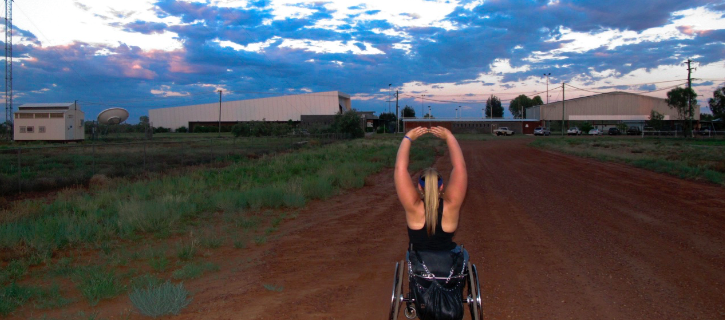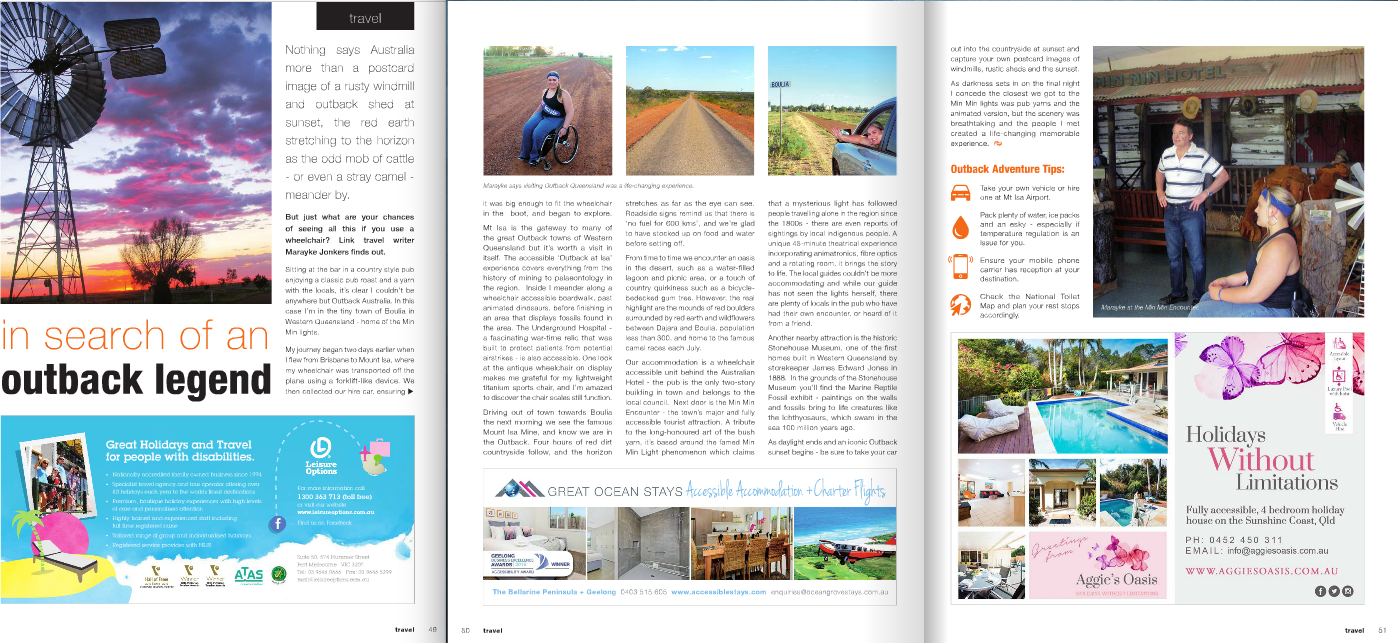IN SEARCH OF AN OUTBACK LEGEND
Nothing says Australia more than a postcard image of a rusty windmill and outback shed at sunset, the red earth stretching to the horizon as the odd mob of cattle – or even a stray camel – meander by.
But just what are your chances of seeing all this if you use a wheelchair? Link travel writer Marayke Jonkers finds out.read in Link Magazine
Sitting at the bar in a country style pub enjoying a classic pub roast and a yarn with the locals, it’s clear I couldn’t be anywhere but Outback Australia. In this case I’m in the tiny town of Boulia in Western Queensland – home of the Min Min lights.
My journey began two days earlier when I flew from Brisbane to Mount Isa, where my wheelchair was transported off the plane using a forklift-like device. We then collected our hire car, ensuring
it was big enough to fit the wheelchair in the boot, and began to explore.
Mt Isa is the gateway to many of the great Outback towns of Western Queensland but it’s worth a visit in itself. The accessible ‘Outback at Isa’ experience covers everything from the history of mining to palaeontology in the region. Inside I meander along a wheelchair accessible boardwalk, past animated dinosaurs, before finishing in an area that displays fossils found in the area. The Underground Hospital – a fascinating war-time relic that was built to protect patients from potential airstrikes – is also accessible. One look at the antique wheelchair on display makes me grateful for my lightweight titanium sports chair, and I’m amazed to discover the chair scales still function.
Driving out of town towards Boulia the next morning we see the famous Mount Isa Mine, and know we are in the Outback. Four hours of red dirt countryside follow, and the horizon stretches as far as the eye can see. Roadside signs remind us that there is ‘no fuel for 600 kms’, and we’re glad to have stocked up on food and water before setting off.
From time to time we encounter an oasis in the desert, such as a water-filled lagoon and picnic area, or a touch of country quirkiness such as a bicycle-bedecked gum tree. However, the real highlight are the mounds of red boulders surrounded by red earth and wildflowers between Dajara and Boulia, population less than 300, and home to the famous camel races each July.
Our accommodation is a wheelchair accessible unit behind the Australian Hotel – the pub is the only two-story building in town and belongs to the local council. Next door is the Min Min Encounter – the town’s major and fully accessible tourist attraction. A tribute to the long-honoured art of the bush yarn, it’s based around the famed Min Min Light phenomenon which claims that a mysterious light has followed people travelling alone in the region since the 1800s – there are even reports of sightings by local indigenous people. A unique 45-minute theatrical experience incorporating animatronics, fibre optics and a rotating room, it brings the story to life. The local guides couldn’t be more accommodating and while our guide has not seen the lights herself, there are plenty of locals in the pub who have had their own encounter, or heard of it from a friend.
Another nearby attraction is the historic Stonehouse Museum, one of the first homes built in Western Queensland by storekeeper James Edward Jones in 1888. In the grounds of the Stonehouse Museum you’ll find the Marine Reptile Fossil exhibit – paintings on the walls and fossils bring to life creatures like the Ichthyosaurs, which swam in the sea 100 million years ago.
As daylight ends and an iconic Outback sunset begins – be sure to take your car out into the countryside at sunset and capture your own postcard images of windmills, rustic sheds and the sunset.
As darkness sets in on the final night I concede the closest we got to the Min Min lights was pub yarns and the animated version, but the scenery was breathtaking and the people I met created a life-changing memorable experience.
Outback Adventure Tips:
Take your own vehicle or hire one at Mt Isa Airport.
Pack plenty of water, ice packs and an esky – especially if temperature regulation is an issue for you.
Ensure your mobile phone carrier has reception at your destination.
Check the National Toilet Map and plan your rest stops accordingly.

